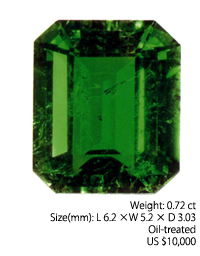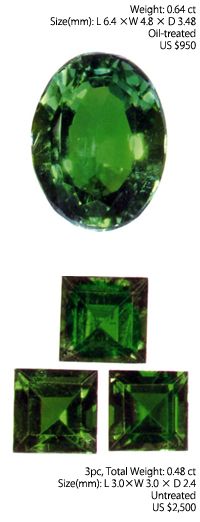CHARACTERISTICS BY BY COUNTRY OF ORIGIN
Currently, the main source of emerald is Colombia, which accounts for about 50 percent of global production. Zambia produces about 20 percent and Brazil about 15 percent, with Zimbabwe said to follow Brazil. Much of the emerald trade is on the gray market, however, and accurate data is impossible to gather. Other sources include Pakistan, Afghanistan, Australia, Madagascar, Tanzania, and Russia, but these countries do not produce large enough quantities to influence the market.
|
 |
Colombia
Colombian emerald is characterized by rough stones that often occur as hexagonal cylinders. Taking advantage of this characteristic, rough is usually fashioned into emerald cuts, preserving concentrations of green that occur near the surface like a “skin” of color, and maximizing weight retention. The shape of many gemstones is thus restricted by the shape of the rough; for example, pear- and marquise-shape diamonds also tale advantage of the shape of the natural rough, and are cut in a manner that reduces weight loss to a minimum.
|
|
Zambia
Zambian emerald rough is often a rounded shape, which is fashioned into oval cuts to avoid the significant weight loss that would result from an emerald cut. It is an interesting fact that Zambian emerald resembles some Brazilian material in hue, the shape of the rough, and inclusions. This is attributed to similarities in their modes of formation. In addition to ovals, pear-shape cuts are also commonly seen in Zambian emeralds. |
 |
Zimbabwe
Emeralds from Zimbabwe are known by the name of the deposit they are mined from, Sandawana. These emeralds are small, with cut material weighing an average of about 0.08 carats, but they possess a uniquely attractive yellowish green hue. Fashioned as rounds and squares, Sandawana emeralds are used as components in high-priced jewelry. Most polishing is done in Zimbabwe, with a portion being carried out in Jaipur, India. |
|
 |
JUDGING QUALITY
The green of Zambian emerald differs from that of the material from Colombia and Zimbabwe. The color, believed to be caused by the element vanadium, is distributed evenly throughout the stone, while the chromium-based green in Colombian material tends to be confined to the surface. It is odd that the unevenly colored Colombian material should appear more attractive than the homogenous material from Zambia, but this serves as an illustration of the complex interaction between various factors such as transparency, intensity of color, pleochroism, richness or depth of color, inclusions, and hue or tint.
Attractive Zambian emeralds are available in oval shapes, mostly in weights of around 0.5 carats. Having high levels of transparency and deep hues, these are used in high-quality jewelry. However, most material is of accessory quality that has been filled with oils or resins, with tones of 3 to 4 and beauty grades in the C and D zones. Some stones are cut to sizes exceeding 2 carats, but they lack the warmth of the Colombian material, perhaps due to their homogenous color that exhibits a cooler, strongly bluish hue.
|
| |
HOW TO CHOOSE
When shopping for accessory-quality emeralds of around 0.5 carats, Zambian oval cuts are an optimum choice. In accessory qualities, these are usually not distinguished from Brazilian stones, and the two are often handled together.
|
|